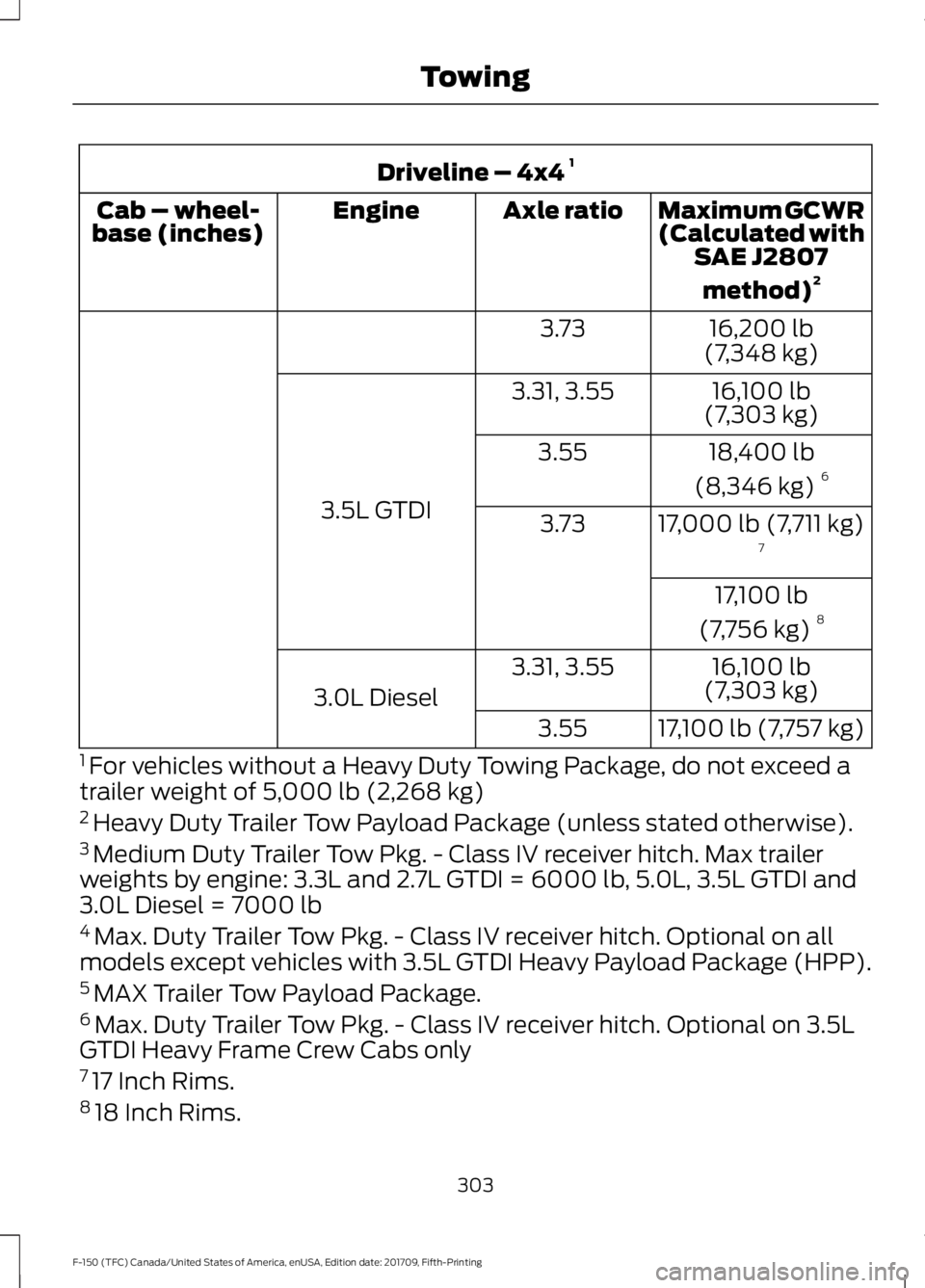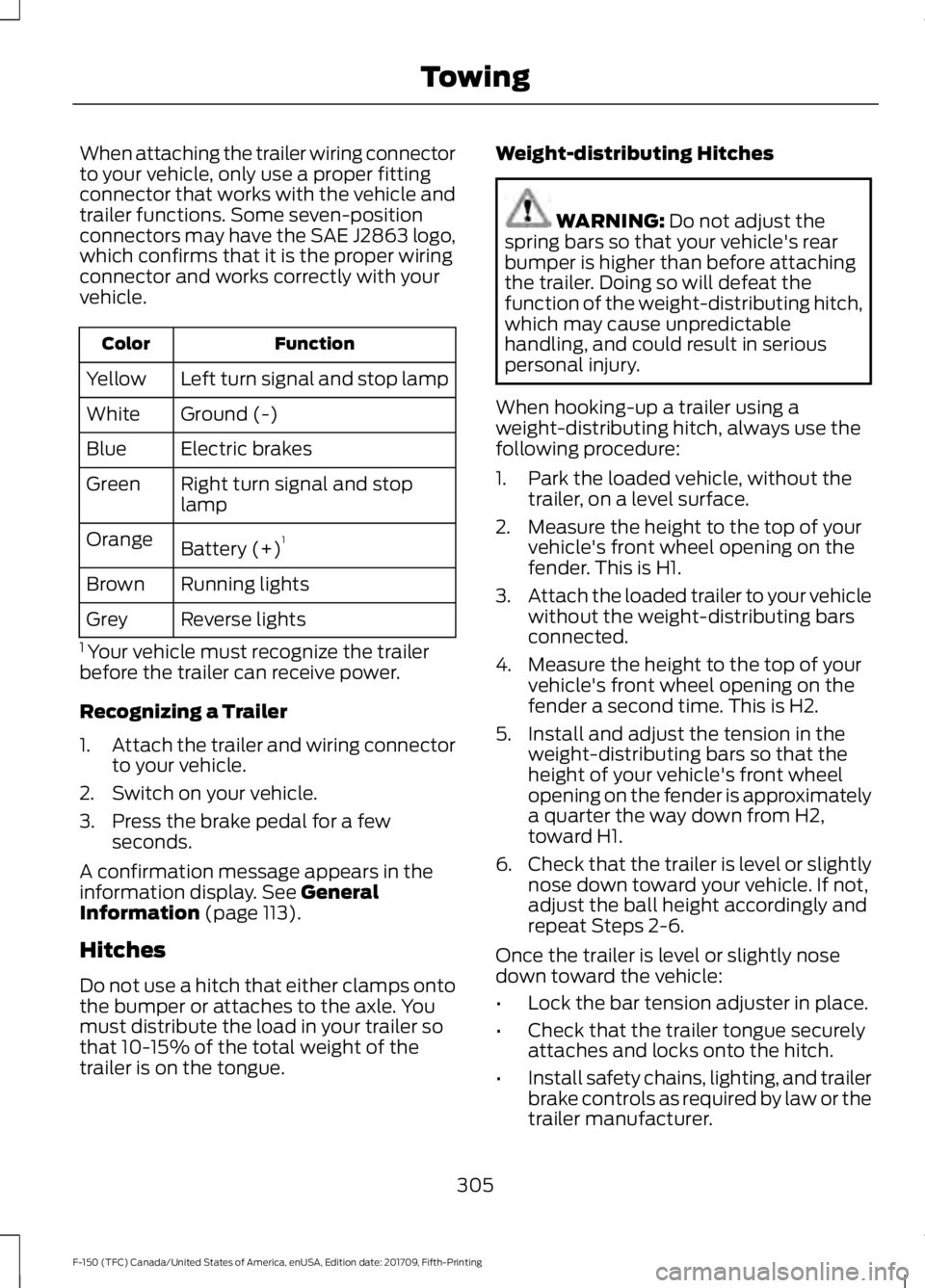Page 301 of 641
Driveline – 4x2
1
Maximum GCWR
(Calculated withSAE J2807
method) 2
Axle ratio
Engine
Cab – wheel-
base (inches)
18,400 lb
(8,346 kg) 6
3.55
17,100 lb (7,756 kg)4
3.73
1 For vehicles without a Heavy Duty Towing Package, do not exceed a
trailer weight of 5,000 lb (2,268 kg)
2 Heavy Duty Trailer Tow Payload Package (unless stated otherwise).
3 Medium Duty Trailer Tow Pkg. - Class IV receiver hitch. Max trailer
weights by engine: 3.3L and 2.7L GTDI = 6000 lb, 5.0L, 3.5L GTDI and
3.0L Diesel = 7000 lb
4 Max. Duty Trailer Tow Pkg. - Class IV receiver hitch. Optional on all
models except vehicles with 3.5L GTDI Heavy Payload Package (HPP).
5 MAX Trailer Tow Payload Package.
6 Max. Duty Trailer Tow Pkg. - Class IV receiver hitch. Optional on 3.5L
GTDI Heavy Frame Crew Cabs only.
298
F-150 (TFC) Canada/United States of America, enUSA, Edition date: 201709, Fifth-Printing Towing
Page 302 of 641
Driveline – 4x4
1
Maximum GCWR
(Calculated withSAE J2807
method) 2
Axle ratio
Engine
Cab – wheel-
base (inches)
9,700 lb
(4,400 kg) 3
3.55
3.3L TiVCT
Regular cab – 122 12,200 lb
(5,534 kg)
3.73
12,500 lb
(5,670 kg)
3.55
2.7L GTDI 13,300 lb
(6,033 kg)
3.73
13,200 lb
(5,987 kg)
3.31, 3.55
5.0L TiVCT 14,600 lb
(6,622 kg)
3.73
12,200 lb
(5,534 kg)
3.73
3.3L TiVCT
Regular cab – 141 12,600 lb
(5,715 kg)
3.55
2.7L GTDI 13,300 lb
(6,033 kg)
3.73
14,100 lb
(6,396 kg) 5
3.73
14,100 lb
(6,396 kg)
3.31, 3.55
5.0L TiVCT 16,200 lb
(7,348 kg)
3.73
299
F-150 (TFC) Canada/United States of America, enUSA, Edition date: 201709, Fifth-Printing Towing
Page 303 of 641
Driveline – 4x4
1
Maximum GCWR
(Calculated withSAE J2807
method) 2
Axle ratio
Engine
Cab – wheel-
base (inches)
16,100 lb
(7,303 kg) 7
3.73
16,100 lb
(7,303 kg) 8
15,800 lb
(7,166 kg)
3.31, 3.55
3.5L GTDI 17,100 lb
(7,756 kg) 4
3.55
17,100 lb
(7,756 kg) 4
3.73
12,500 lb
(5,670 kg)
3.73
3.3L TiVCT
Super Cab – 145 12,800 lb
(5,806 kg)
3.55
2.7L GTDI 13,300 lb
(6,033 kg)
3.73
14,299 lb
(6,486 kg) 5
3.73
14,299 lb
(6,486 kg)
3.31
5.0L TiVCT 14,400 lb
(6,532 kg)
3.55
16,500 lb
(7,484 kg)
3.73
300
F-150 (TFC) Canada/United States of America, enUSA, Edition date: 201709, Fifth-Printing Towing
Page 304 of 641
Driveline – 4x4
1
Maximum GCWR
(Calculated withSAE J2807
method) 2
Axle ratio
Engine
Cab – wheel-
base (inches)
16,000 lb
(7,257 kg)
3.31, 3.55
3.5L GTDI 17,100 lb
(7,756 kg) 4
3.55
14,400 lb
(6,532 kg)
3.31
5.0L TiVCT
Super Cab – 163 14,500 lb
(6,577 kg)
3.55
16,600 lb
(7,530 kg)
3.73
16,200 lb
(7,348 kg)
3.73
16,200 lb
(7,348 kg)
3.31, 3.55
3.5L GTDI 16,200 lb
(7,348 kg) 4
3.55
16,200 lb
(7,348 kg) 4
3.73
12,600 lb
(5,715 kg)
3.73
3.3L TiVCT
Crew cab – 145 12,900 lb
(5,851 kg)
3.55
2.7L GTDI 13,300 lb
(6,033 kg)
3.73
301
F-150 (TFC) Canada/United States of America, enUSA, Edition date: 201709, Fifth-Printing Towing
Page 305 of 641
Driveline – 4x4
1
Maximum GCWR
(Calculated withSAE J2807
method) 2
Axle ratio
Engine
Cab – wheel-
base (inches)
14,300 lb
(6,486 kg) 5
3.73
14,300 lb
(6,486 kg)
3.31
5.0L TiVCT 14,400 lb
(6,532 kg)
3.55
16,200 lb
(7,348 kg)
3.73
16,100 lb
(7,303 kg)
3.31, 3.55
3.5L GTDI 18,400 lb
(8,346 kg) 6
3.55
16,100 lb
(7,303 kg)
3.31
3.5L 10.5:1 CR 16,700 lb
(7,575 kg)
3.55
16,000 lb
(7,257 kg)
3.31, 3.55
3.0L Diesel 17,100 lb
(7,756 kg)
3.55
14,400 lb
(6,532 kg)
3.31
5.0L TiVCT
Crew cab – 157 14,500 lb
(6,577 kg)
3.55
16,900 lb
(7,666 kg)
3.73
302
F-150 (TFC) Canada/United States of America, enUSA, Edition date: 201709, Fifth-Printing Towing
Page 306 of 641

Driveline – 4x4
1
Maximum GCWR
(Calculated withSAE J2807
method) 2
Axle ratio
Engine
Cab – wheel-
base (inches)
16,200 lb
(7,348 kg)
3.73
16,100 lb
(7,303 kg)
3.31, 3.55
3.5L GTDI 18,400 lb
(8,346 kg) 6
3.55
17,000 lb (7,711 kg)7
3.73
17,100 lb
(7,756 kg) 8
16,100 lb
(7,303 kg)
3.31, 3.55
3.0L Diesel
17,100 lb (7,757 kg)
3.55
1 For vehicles without a Heavy Duty Towing Package, do not exceed a
trailer weight of 5,000 lb (2,268 kg)
2 Heavy Duty Trailer Tow Payload Package (unless stated otherwise).
3 Medium Duty Trailer Tow Pkg. - Class IV receiver hitch. Max trailer
weights by engine: 3.3L and 2.7L GTDI = 6000 lb, 5.0L, 3.5L GTDI and
3.0L Diesel = 7000 lb
4 Max. Duty Trailer Tow Pkg. - Class IV receiver hitch. Optional on all
models except vehicles with 3.5L GTDI Heavy Payload Package (HPP).
5 MAX Trailer Tow Payload Package.
6 Max. Duty Trailer Tow Pkg. - Class IV receiver hitch. Optional on 3.5L
GTDI Heavy Frame Crew Cabs only
7 17 Inch Rims.
8 18 Inch Rims.
303
F-150 (TFC) Canada/United States of America, enUSA, Edition date: 201709, Fifth-Printing Towing
Page 307 of 641

Calculating the Maximum
Loaded Trailer Weight for Your
Vehicle
1. Start with the gross combined
weight rating for your vehicle
model and axle ratio. See the
previous charts.
2. Subtract all of the following
that apply to your vehicle:
• Vehicle curb weight.
• Hitch hardware weight, for
example a draw bar, ball, locks
or weight distributing hardware.
• Driver weight.
• Passenger(s) weight.
• Payload, cargo and luggage
weight.
• Aftermarket equipment weight.
This equals the maximum loaded
trailer weight for this combination.
Note: The trailer tongue load is
considered part of the payload for
your vehicle. Reduce the total
payload by the final trailer tongue
weight.
Note: Consult an authorized dealer
to determine the maximum trailer
weight allowed for your vehicle if
you are not sure.
ESSENTIAL TOWING CHECKS
Follow these guidelines for safe towing:
• Do not tow a trailer until you drive your
vehicle at least 1,000 mi (1,600 km).
• Consult your local motor vehicle laws
for towing a trailer. •
See the instructions included with
towing accessories for the proper
installation and adjustment
specifications.
• Service your vehicle more frequently if
you tow a trailer. See your scheduled
maintenance information.
See
Scheduled Maintenance (page 561).
• If you use a rental trailer, follow the
instructions the rental agency gives
you.
See
Load limits in the Load Carrying
chapter for load specification terms found
on the tire label and Safety Compliance
label and instructions on calculating your
vehicle's load. See Load Limit (page 272).
Remember to account for the trailer
tongue weight as part of your vehicle load
when calculating the total vehicle weight.
Trailer Towing Connector 304
F-150 (TFC) Canada/United States of America, enUSA, Edition date: 201709, Fifth-Printing TowingE193232
Page 308 of 641

When attaching the trailer wiring connector
to your vehicle, only use a proper fitting
connector that works with the vehicle and
trailer functions. Some seven-position
connectors may have the SAE J2863 logo,
which confirms that it is the proper wiring
connector and works correctly with your
vehicle.
Function
Color
Left turn signal and stop lamp
Yellow
Ground (-)
White
Electric brakes
Blue
Right turn signal and stop
lamp
Green
Battery (+) 1
Orange
Running lights
Brown
Reverse lights
Grey
1 Your vehicle must recognize the trailer
before the trailer can receive power.
Recognizing a Trailer
1. Attach the trailer and wiring connector
to your vehicle.
2. Switch on your vehicle.
3. Press the brake pedal for a few seconds.
A confirmation message appears in the
information display. See General
Information (page 113).
Hitches
Do not use a hitch that either clamps onto
the bumper or attaches to the axle. You
must distribute the load in your trailer so
that 10-15% of the total weight of the
trailer is on the tongue. Weight-distributing Hitches WARNING:
Do not adjust the
spring bars so that your vehicle's rear
bumper is higher than before attaching
the trailer. Doing so will defeat the
function of the weight-distributing hitch,
which may cause unpredictable
handling, and could result in serious
personal injury.
When hooking-up a trailer using a
weight-distributing hitch, always use the
following procedure:
1. Park the loaded vehicle, without the trailer, on a level surface.
2. Measure the height to the top of your vehicle's front wheel opening on the
fender. This is H1.
3. Attach the loaded trailer to your vehicle
without the weight-distributing bars
connected.
4. Measure the height to the top of your vehicle's front wheel opening on the
fender a second time. This is H2.
5. Install and adjust the tension in the weight-distributing bars so that the
height of your vehicle's front wheel
opening on the fender is approximately
a quarter the way down from H2,
toward H1.
6. Check that the trailer is level or slightly
nose down toward your vehicle. If not,
adjust the ball height accordingly and
repeat Steps 2-6.
Once the trailer is level or slightly nose
down toward the vehicle:
• Lock the bar tension adjuster in place.
• Check that the trailer tongue securely
attaches and locks onto the hitch.
• Install safety chains, lighting, and trailer
brake controls as required by law or the
trailer manufacturer.
305
F-150 (TFC) Canada/United States of America, enUSA, Edition date: 201709, Fifth-Printing Towing